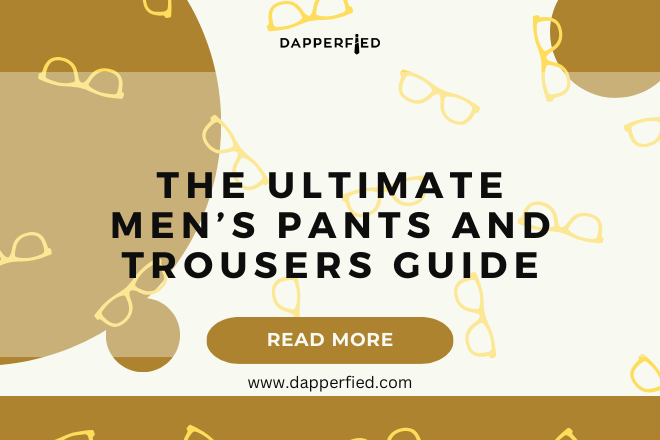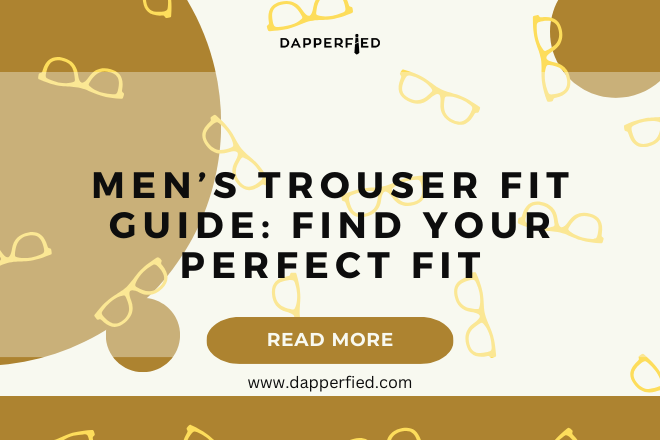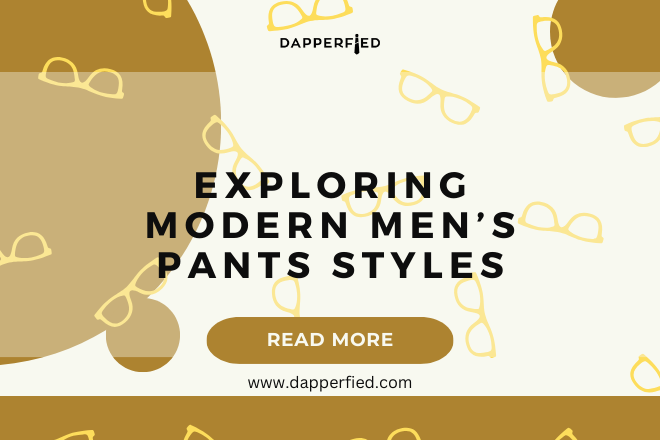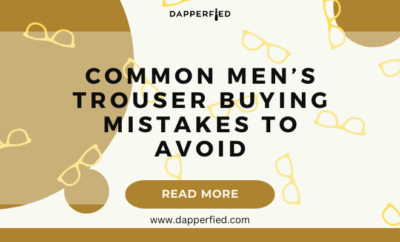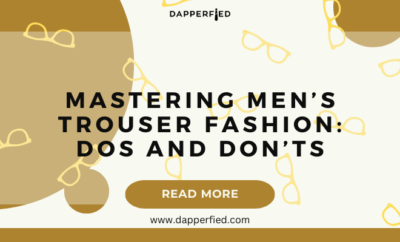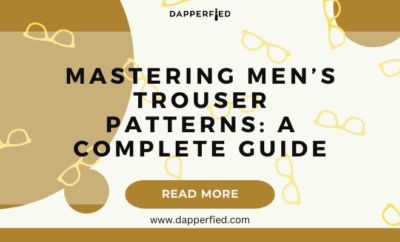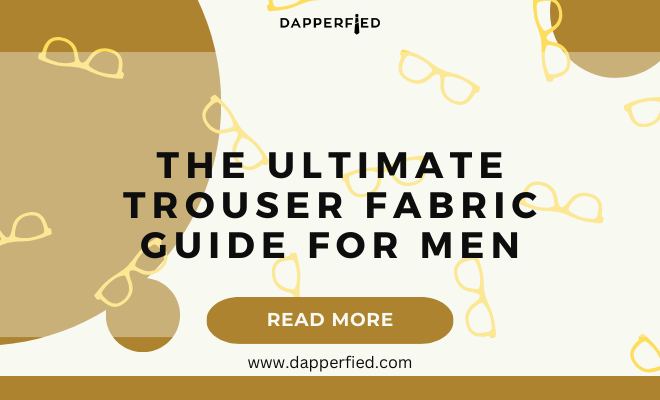
Men's Style
The Ultimate Trouser Fabric Guide for Men
When it comes to choosing the right fabric for your trousers, it’s important to understand the different types of fabrics available. Some common trouser fabrics include cotton, wool, linen, polyester, and blends of these materials. Cotton is a popular choice for trousers due to its breathability and comfort. It’s a versatile fabric that can be worn in both casual and formal settings. Wool is another popular choice for trousers, especially in colder climates. It’s known for its warmth and durability, making it a great option for dress trousers. Linen is a lightweight and breathable fabric that is perfect for summer trousers. It has a relaxed and casual look, making it ideal for warm weather. Polyester is a synthetic fabric that is often blended with other materials to add durability and wrinkle resistance to trousers.
In addition to these fabrics, there are also blends that combine two or more materials to create unique properties. For example, a cotton-polyester blend may offer the breathability of cotton with the wrinkle resistance of polyester. Understanding the characteristics of each fabric will help you make an informed decision when choosing trousers for different occasions.
Key Takeaways
- Different types of trouser fabrics include cotton, wool, linen, polyester, and blends
- Choose the right fabric based on your lifestyle, considering factors such as comfort, durability, and maintenance
- Fabric weight and seasonality are important considerations when selecting trouser fabrics for different weather conditions
- Quality trouser fabrics can be identified by factors such as thread count, weave, and finishing
- Popular trouser fabrics like denim, chino, and corduroy each have unique characteristics and are suitable for different occasions and styles
- Proper care for trouser fabrics includes following care instructions, avoiding harsh chemicals, and storing them properly
- Pair trouser fabrics with different outfits by considering the fabric’s texture, color, and formality to create stylish and cohesive looks
Choosing the Right Fabric for Your Lifestyle
When choosing the right fabric for your trousers, it’s important to consider your lifestyle and the activities you’ll be engaging in while wearing them. For example, if you have an active lifestyle and need trousers that can withstand a lot of movement, you may want to opt for a fabric with some stretch, such as a cotton-spandex blend. This will allow for greater flexibility and comfort throughout the day. On the other hand, if you work in a professional setting and need trousers that maintain a crisp and polished look, wool or wool-blend trousers may be the best choice. These fabrics are known for their ability to hold their shape and resist wrinkles, making them ideal for long days at the office.
For those who live in warmer climates or have an upcoming vacation in a tropical destination, linen trousers are a great option. The lightweight and breathable nature of linen makes it perfect for hot weather, allowing you to stay cool and comfortable while still looking stylish. By considering your lifestyle and the specific occasions you’ll be wearing your trousers for, you can choose the right fabric that meets your needs and enhances your overall comfort and style.
The Importance of Fabric Weight and Seasonality
Fabric weight plays a crucial role in the seasonality of trousers. Lighter weight fabrics such as linen and lightweight cotton are ideal for summer months, as they allow for breathability and comfort in hot weather. On the other hand, heavier weight fabrics like wool are better suited for colder seasons, providing warmth and insulation against the elements. Understanding the seasonality of different fabrics will help you make appropriate choices when building your wardrobe.
It’s also important to consider the weight of the fabric in relation to the specific occasion. For formal events or professional settings, heavier weight fabrics like wool or wool-blend trousers are often preferred for their structured and polished appearance. On the other hand, casual outings or relaxed settings may call for lighter weight fabrics like cotton or linen, which offer a more laid-back and comfortable feel. By paying attention to fabric weight and seasonality, you can ensure that your trousers are not only stylish but also practical for the specific time and place.
How to Identify Quality Trouser Fabrics
| Fabric Type | Quality Indicator |
|---|---|
| Cotton | Softness, breathability, durability |
| Wool | Warmth, wrinkle resistance, durability |
| Polyester | Wrinkle resistance, durability, easy care |
| Linen | Breathability, lightweight, natural texture |
| Viscose | Softness, drape, breathability |
Identifying quality trouser fabrics is essential when making a purchase. One way to determine the quality of a fabric is by examining its density and weave. High-quality fabrics are often tightly woven, which contributes to their durability and longevity. Additionally, inspecting the fabric for any irregularities or flaws can help identify its quality. Look for evenness in color and texture, as well as minimal pilling or loose threads.
Another indicator of quality trouser fabrics is their feel and drape. Quality fabrics tend to have a smooth and luxurious feel, with a good drape that enhances the overall look of the trousers. When shopping for trousers, take the time to touch and feel the fabric to gauge its quality. Additionally, consider the reputation of the brand or manufacturer, as reputable companies are more likely to use high-quality fabrics in their products.
Popular Trouser Fabrics and Their Characteristics
Cotton is a popular choice for trousers due to its breathability and comfort. It’s a versatile fabric that can be worn in both casual and formal settings. Wool is another popular choice for trousers, especially in colder climates. It’s known for its warmth and durability, making it a great option for dress trousers. Linen is a lightweight and breathable fabric that is perfect for summer trousers. It has a relaxed and casual look, making it ideal for warm weather. Polyester is a synthetic fabric that is often blended with other materials to add durability and wrinkle resistance to trousers.
In addition to these fabrics, there are also blends that combine two or more materials to create unique properties. For example, a cotton-polyester blend may offer the breathability of cotton with the wrinkle resistance of polyester. Understanding the characteristics of each fabric will help you make an informed decision when choosing trousers for different occasions.
Caring for Your Trouser Fabrics

Proper care is essential for maintaining the quality and longevity of your trouser fabrics. Always follow the care instructions provided by the manufacturer to ensure that your trousers remain in good condition. For example, some fabrics may require dry cleaning, while others can be machine washed or hand washed at home.
When storing your trousers, it’s important to hang them properly to prevent wrinkles and maintain their shape. Invest in quality hangers that support the weight of the trousers without causing creases or stretching. Additionally, consider using garment bags to protect your trousers from dust and moths when not in use.
Regular maintenance such as spot cleaning stains and removing lint or pet hair will also help keep your trousers looking fresh and well-maintained. By taking proper care of your trouser fabrics, you can extend their lifespan and continue to enjoy their comfort and style for years to come.
Tips for Pairing Trouser Fabrics with Different Outfits
When it comes to pairing trouser fabrics with different outfits, it’s important to consider the overall look you want to achieve. For a casual and relaxed style, consider pairing cotton or linen trousers with a simple t-shirt or polo shirt. This combination is perfect for weekend outings or casual gatherings with friends.

For a more polished and professional look, opt for wool or wool-blend trousers paired with a button-down shirt and blazer. This ensemble is suitable for business meetings, formal events, or professional settings where a sophisticated appearance is required.
When it comes to footwear, consider the style of your trousers when choosing shoes. For example, slim-fit trousers pair well with dress shoes or loafers for a refined look, while wide-leg trousers can be styled with sneakers or casual boots for a more laid-back vibe.
By understanding how different trouser fabrics can be paired with various outfits, you can create versatile looks that suit different occasions and reflect your personal style. Experiment with different combinations to find what works best for you and don’t be afraid to mix and match different fabrics to create unique and stylish ensembles.
If you’re looking for more tips on what to wear at work, check out this article on proper work attire from Dapperfied. It offers great advice on how to dress professionally and stylishly in the workplace. Whether you’re in need of a new suit or just want to brush up on your RSVP etiquette, Dapperfied has you covered with their informative articles. Check it out here!
FAQs
What are the most common types of trouser fabric for men?
The most common types of trouser fabric for men include cotton, wool, linen, and synthetic blends such as polyester and rayon.
What is the best trouser fabric for formal occasions?
Wool is considered the best trouser fabric for formal occasions due to its luxurious look and feel, as well as its ability to drape well and resist wrinkles.
What is the most breathable trouser fabric for men?
Linen is known for being the most breathable trouser fabric for men, making it a popular choice for warm weather and casual wear.
What is the most durable trouser fabric for men?
Cotton is known for its durability, making it a popular choice for everyday wear. It is also easy to care for and can be worn in a variety of settings.

What are the advantages of synthetic trouser fabrics?
Synthetic trouser fabrics such as polyester and rayon are known for their wrinkle resistance, durability, and affordability. They are also easy to care for and can mimic the look and feel of natural fabrics.

